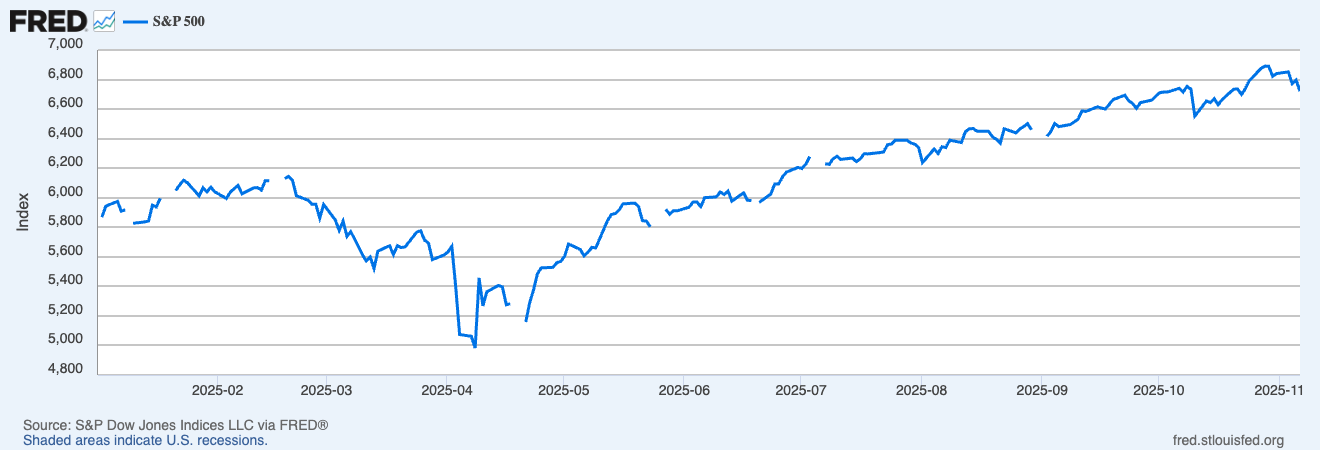- WEALTH, EMPOWERED by Jonathan Treussard
- Posts
- “Up and to the Right” + Advanced Tax Strategies
“Up and to the Right” + Advanced Tax Strategies
TL;DR: In case it's been a long week, here is the short version…
It is worth understanding why the stock market has gone up in the U.S. over the past 150 years. If you don't, you're operating on blind faith. Ask yourself what happens when the market tests that faith.
And as importantly, a lot had to go right to make up for all the things that inherently go wrong over time. We should not take any of it for granted.
And if you're curious about advanced tax-savvy investment strategies, you'll want to listen to my conversation with Brent Sullivan.
I don't often flex the "I'm a Doctor, everyone" muscle, but the following is doctor's orders: Listen to Bobby McFerrin at least once this weekend. It’s the remedy for a lot of heartache in this world.
“Up and to the Right,” they say
It’s worth your while to get clear about what drives markets over the long run.
Otherwise, we’re operating on pure faith, which has a nasty habit of getting polluted with doubt when we hit our first pothole.
Plus, after the rally we've experienced since the dark days of April — and given the slight tremors of the last few days — now is probably as good a time as any to remind ourselves what this whole thing is about, should our faith be properly shaken again at some point in the not-so-distant future.

When people want to sound smart — like they've thought about investing for a long time — they say things like:
Well, you know, stocks go up and to the right over the long run.
Of course, what one envisions while saying this is a graph much like the one above, where stock prices (or "levels") are plotted on the vertical axis against time on the horizontal axis.
My generous interpretation is that it’s meant as an encouragement to tune out the ups and downs of the market from one day to the next, one month to the next, and even one year to the next.
At the intersection of investment discipline and mental self-care, I'm all in on doing whatever you can to tune out the noise.
But when you start making scientific-sounding declarations and predictive statements, you have — as Ricky Ricardo may or may not have ever said to Lucy — some 'splainin' to do. (Look up the "Mandela Effect" if you want to have fun with that one.)
Let’s break that down.
Has the stock market gone up in value over the last 150 years or so in the United States, thereby generating immense wealth for those holding a portfolio resembling the “market” through the decades?
Yes, indeed that did happen.
Was that wealth-generation process interrupted sharply multiple times in the modern era by declines and crashes that destroyed the hopes and dreams of specific families and individuals along the way?
Also yes, though far fewer investors jumped off buildings on the worst days than public lore would have it. (Here again, perceptions and facts have been wedged apart from each other.)
To put it simply, unless you had sufficient wealth and discipline to "ride the ride," start to finish, unflinching and even adding to your holdings at the most trying of times, the fact that the U.S. stock market chart looks like it does over the last one and a half centuries may not be as comforting as it sounds.
But the past is the past, and the point stands, as a matter of historical record.
Where things can really go off the rails is when you start using the present tense to describe the past, as in "stocks go up and to the right."
Really, this is a law of physics?
Like it always has and always will happen?
I don’t think so, and this is not a matter of personal opinion.
If the wisdom of the regulatory disclaimer that "past returns do not guarantee future results" isn't enough for you — and it should be — let me point you to extraordinary research by William Goetzmann and the late (and great) Philippe Jorion, published near the end of the 1990s.
Goetzmann and Jorion looked at stock markets from around the world throughout the 20th century, and they tell us about 11 markets that experienced "disappearance as an event." That's as bad as it sounds.
They say "these cases include Germany, Japan, Eastern European countries taken over by the Soviet Union, Greece, Chile, Argentina, and Portugal. Some of these were the result of foreign occupation and widespread destruction due to war. In Egypt and Chile, the state took control of the economy. These are precisely the situations where we would expect equities to fare most badly."
Turns out, being turned into a Soviet republic for a few decades wasn’t great for local stock investors.
Shocking, right?
And it also turns out the post–Civil War United States has had a truly exceptional run of history relative to her international peers: no war here, no revolution, and relative stability of institutions, leaving us free to channel our desires for progress into private enterprise (aka capitalism, as the term goes).
OK, by now, I hope you get the basic point…
There is no magical force out there that pushes stocks "up and to the right" if just given time.
And with magic out of the way, we are left with the heavy lifting of human actions, and those do not come with guarantees.
This last piece is our final sprint to the finish line.
Let's set up the simplest way to think about stocks that we can come up with.
(This will ignore critical things, like "valuations," but over centuries, there is reason to think that valuations aren't as first-order as they are over the next ten years, say.)
Let's pretend that stock prices represent the value today of a few years' worth of future cash earned by the stock's owners. In the textbooks, they call that "discounted present value."
And let's just pretend for the sake of exposition that people only care about the next ten years, and that the company in question is all set to spit out $100 of cash to its owners every year for the next ten years.
And let's make one more silly assumption... Assume that interest rates are zero (or that people don't care about interest rates much at all when valuing stocks), so that the "discounting" math is as easy as possible.
One hundred bucks every year for ten years — that's $1,000 total.
In this silly simple world, the price of the stock would be $1,000 today.
Now let's just pretend that ten years go by and that the business is managed reasonably well — just well enough, in fact, to keep its operations going at a steady level into the next decade.
What would the stock price be in ten years?
Well, if keeping the business steady means being able to generate another $100 a year again for the next ten years, then the stock price would again be $1,000.
No "up and to the right" stuff… Just steady, sitting there at $1,000.
What are we supposed to take away from this silly little model?
Simple… For stock prices to even have a shot at going up and to the right, “steady” isn’t good enough. Not even close.
We need the ability to generate more value for customers, thus more revenue with greater efficiency, and finally more cash to shareholders as a result.
If it sounds exhausting, that's because it's a lot of work.
And a lot has to go right, like it has in the United States over the last 150 years or so, given how many things inherently go wrong along the way.
We shouldn't take any of it for granted.
But boy, does it feel like magic to see what a free people channeling our collective desire for progress into private enterprise can accomplish.
Advanced Tax Strategies with Brent Sullivan, aka the Tax Alpha Insider.
Let's talk "tax alpha" on the way out… I recently interviewed Brent Sullivan for TREUSSARD TALKS.
This is a topic that probably gets too much and too little attention.
Too much because it's awfully easy to get people excited about trimming their tax bill.
Too little because most of this is highly technical stuff that slots in cleanly under the "financial engineering" rubric. And when engineering of any kind is involved, details matter an awful lot, too.
So what is tax alpha?
It's the additional after-tax return you can capture through sophisticated portfolio management.
The problems these strategies address are real, like concentrated positions with massive embedded gains that have you locked into single-stock risk you'd never choose today.
Now here's where people get into trouble, and Brent is crystal clear about this: When assessing strategies, tax comes after risk, return, diversification, and cost—not before them.
That's the hierarchy, and it's non-negotiable.
It's tempting to chase tax savings but these are investment decisions with tax implications, not tax solutions that happen to involve investments.
We covered four strategies in detail:
ETF tax efficiency through in-kind redemptions—which works well for U.S. equities but less so for international equities and fixed income. The details and structure matter.
Section 351 in-kind seeding to convert concentrated positions into diversified portfolios—but hard diversification limits mean if 90% of your wealth is in one stock, this can only do so much for you. The seeding diversification tests aren't suggestions.
Tax-aware long/short overlays that can maintain equity exposure while harvesting losses—except margin rates, borrow costs, and collateral haircuts aren't fixed. They can change when your counterparty's risk department decides conditions warrant tighter terms.
Box spreads as synthetic borrowing—four-legged options trades that can provide attractive rates with capital gains treatment on the implied interest. But execution complexity is real: American versus European options, bid-ask spreads on multi-leg trades, collateral requirements. The mechanics matter.
The pattern across all of these? They're sophisticated tools with real costs, real risks, and moving parts that shift with market conditions. Understanding how they actually work is mission-critical to avoid bad outcomes.
Listen to the full conversation here on Apple Podcasts, Spotify, or YouTube.
The controllable factors matter most when markets refuse to cooperate… Here are actions you can take to learn more.
Disclaimer: All content here, including but not limited to charts and other media, is for educational purposes only and does not constitute financial advice. Treussard Capital Management LLC is a registered investment adviser. All investments involve risk and loss of principal is possible.
Full disclaimers: https://www.treussard.com/disclosures-and-disclaimers.

